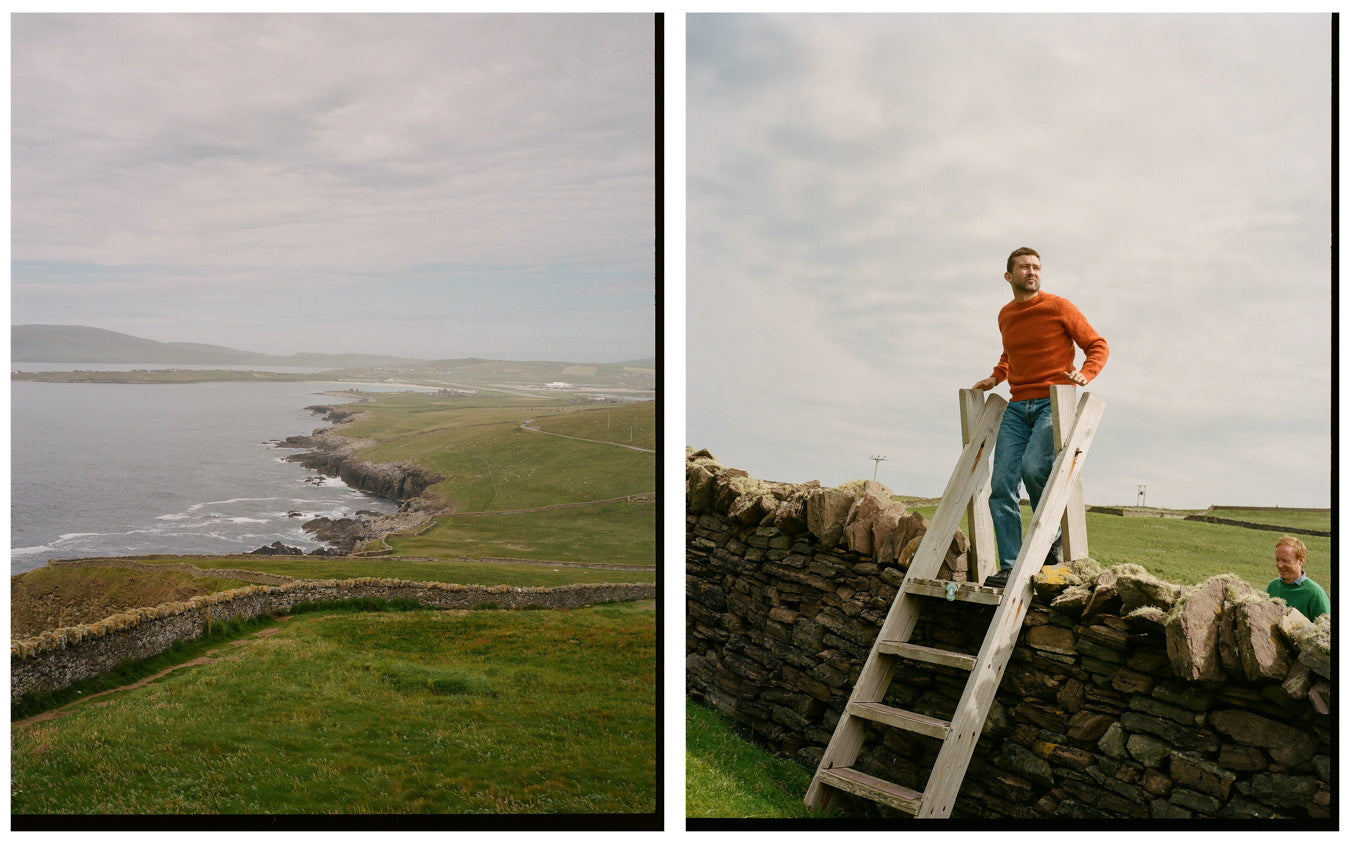A Postcard From Shetland
By Finlay Renwick
Sep 22, 2022

“I tell you what happens,” says Peter Jamieson, standing outside the knitting factory that bears his family name, manicured grass stretching towards a settlement of white-washed houses and then, rolling lazily against the shore, the North Atlantic; the hazy outline of the nearby island of Papa Stour faintly visible through the spindrift of summer. “A couple, not from the island, come here to visit when the sun is shining. They love it and decide to move. ‘It’s beautiful! We can buy a house!’ They arrive, and go through a bad winter, then a bad summer, then one more bad winter, and then they leave. Can’t handle the weather. Not seeing the sun for… god knows how long.”
“You’ve got to be tough to handle the weather here,” says Jamieson. “See that,” he gestures out towards the sea, at ease in the early afternoon, “sometimes the entire horizon, far as you can see. One giant wave. Incredible.”



We’re in the west of Shetland, thankful that the monster waves have taken a few days off. The island’s sheep munch happily in green meadows and birds chirp. Aside from one particular bee that, for reasons unknown, is furious, all is calm. It’s easy to see why, on a day like this, non-islanders fall for the idea of a peaceful island life. A little house by the sea.
Shetland is the windiest place in Britain. So windy that, aside from a few thickets of alder, aspen, Downy birch, rowan and willow in the interior, trees hardly grow here. So windy that Peter remembers, during one especially fierce storm one dark Hogmanay, an entire house, several tons of stone, brick and timber, being picked up and deposited in a nearby field, as easily as a child playing with a doll house.
This wind has drawn companies and prospectors to this rocky outcrop a couple of hundred miles away from the Faroe Isles, where sheep outnumber people 20 to 1. We meet some (people, not sheep) in The Douglas Arms in Lerwick (which means Muddy Bay in old Norse), engineers and contractors, from Aberdeen, Inverness and Manchester, resting their elbows on the bar and drinking pints of Tennants. A 2018 Champions League match featuring Liverpool vs Napoli plays silently on a TV in the corner. The room is painted a deep and bloody red. “I’ve been here for 40 days,” says one man, tiredly and faintly biblically, “and this is the first nice day I’ve seen.” “Go to The Fort Cafe down the road for fish and chips,” says another. “Frankie’s in Brae is better,” says his friend on the adjacent stool, without turning around.



Exnaboe, Boddam Blett, Brow, Cruister Bigton Loch Vanlop, Cunningsburgh, Dandiegarth Fladdabister, Voxter, Kinkwall and Twatt, Shetland’s place names make Tolkein’s Middle Earth map seem dull by comparison. We weave our hire car through empty roads and misty passes, mindful of the island’s famous sheep, who like to amble across the roads in wooly packs when the mood strikes; eyeing us impassively at stop signs and grassy knolls. At one crossing, close to the island’s airport, the banks erupt with heather. “I’ve never seen it flower as much as that,” remarks a young man in high vis to his co-worker.
We stop for a while at a particularly beautiful cove, known as Spiggie beach by locals. Emerald water and pale sand sheltered by mossy cliffs. A group of ducks bob incongruously along the shore line while a black lab canters around in chubby ecstasy. The Vikings must have been pretty impressed when they first showed up. The week before we arrive a pod of killer whales was spotted in a nearby inlet, looking for unfortunate seals.



Frankie’s lives up to the recommendation. Voted Britain’s best fish and chip shop in 2015, it’s also the UK’s most northerly. We sit on outdoor benches, the weather flitting between sun and storm and sideways rain, eating haddock and scallops as beady-eyed gulls swoop overhead. In the summer the sun here hardly sets and in the depths of winter hardly rises. Though you might see the northern lights if you’re lucky. Even in the middle of a grey July night, there is a strange and pale illumination to the place. Slightly Ghostly.
We drink post-dinner Guinness in the Mid Brae Inn, a squat white-washed pub that stands alone off the road. Apparently it nearly burned down in 2012. Contract workers huddle in corners while thumping trance plays on speakers. They’re here to build roads and wind turbines and to extract oil and gas. Fishing is still the big industry on the island, but energy isn’t far off. A bright green sign behind the bar informs patrons that any abusive or threatening behaviour will be met with an instant three month ban. Duly noted. It feels like late afternoon when we leave at 10PM.

The Shetland accent and dialect is unlike the rest of Scotland. As unique and old as its sparse and wonderful landscape. There’s some Scandinavian in there, which makes sense. At the airport in Lerwick a sign, set above one for Bolts Car Hire and Ocean Kinetics, welcomes visitors both new and returning. “Dey’ll meet da folk at’s come sae far ta see dem. As day come in da grinnd, an trow da toon, an say ‘Ye’re wylcom back, we’re blyde ta see you - come in an set you doon.’”
They’ll meet the people who have come so far to see them. As they come through the gate and through the croft, and say. ‘You’re welcome back, we’re glad to see you - come in and sit down.’
We can’t wait to be back.










